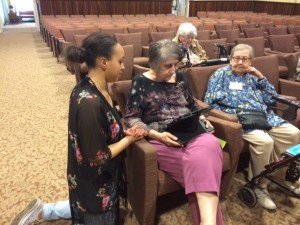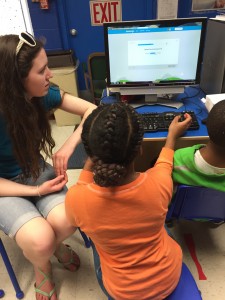UNIV 200-036 | Inquiry and the Craft of Argument (Service-Learning)
Theme: “Technology and Design for Social Innovation”
12:00-12:50 MWF | SLN 25161
“To maximize our own contentment, we seek the minimum amount of technology in our lives. Yet to maximize the contentment of others, we must maximize the amount of technology in the world. Indeed, we can only find our own minimal tools if others have created a sufficient maximum pool of options we can choose from.” —Kevin Kelly
Technology has undoubtedly brought many benefits to our lives, but it is not “one size fits all.” What if groups are not aware of the full range of options, or lack access to them? When are alternatives to mainstream technologies actually better suited to their needs? Students will explore these questions in the context of their service and research.
In this course, technology will be broadly defined as a process or object whereby knowledge is applied to achieve a goal or solve problems. It could be a humble pencil or the latest tablet, an assistive technology used by an individual with a disability, or even a social campaign, such as the effort to improve access to heathy food. The design of technology favors particular outcomes and certain users, so the course will consider how its intentions play out in a social context. Indeed, the goal will be to approach designed technologies as social innovations: “new ideas (products, services and models) that simultaneously meet social needs and create new social relationships or collaborations” (The Open Book of Social Innovation).
“The evolution of design to design thinking is the story of the evolution of the creation of products to the analysis of people to products, and from there to the relationship between people and people. … With the growth of the Internet, it has become clear that we must extend our understanding to the social interactions of people within groups and to the interactions among groups themselves. Any Web-based service—from social networking sites to mobile phone offerings to the vast world of online gaming—requires an understanding of the dynamic interactions within and between larger groups.” —Tim Brown
Students will be participants in the communities they are serving, which means they must see the impact of technology beyond themselves and beyond the individual level. Their direct service will involve helping a community partner or those it serves use certain designed technologies to meet their needs, which gives students the occasion to examine the designed technologies a group already uses and explore how or why its members use them.
A portion of students’ service (4–6 hours out of the required 20 hours) will center on collaboratively designing a technology to achieve a particular goal that benefits their community partner. Students must apply their research to the design of their tool and tailor the solution to the specific situation, drawing on what they learned from their experience serving their partner. Here are a couple examples of past indirect service projects:
- creating a social media presence for a community partner
- authoring how-to manuals to help community members learn how to use the features of a web application
Students’ indirect service projects will inspire a research question on a particular designed technology, which they will answer by combining intensive research using many library and Web sources with their reflections on experiences in the community. Consider these examples investigating social innovations based on actual student inquiries and applicable to the course’s community partners:
- How do schools integrate new educational technologies into the classroom to improve how middle-school students learn?
- How do the elderly use the Internet to increase their quality of life?
- Why is recidivism linked to the lack of access to current technologies?
UNIV 200 is a required core curriculum course for all undergraduates at VCU, centered on developing skills in written communication, argumentation, critical thinking, and information fluency. Students develop a question, perform research to find an answer, then arrive at an argument that synthesizes their findings, which they share in the form of an traditional essay and translate into a partially or fully visual or oral medium (e.g., infographic, presentation, etc.).
I teach service-learning designated sections of UNIV 200 where students contribute 20 hours of service* to a community partner as part of their work in the course. Service-learning transforms how students engage with the course material and design and carry out their research projects. I argue that it offers many benefits over traditional sections of UNIV 200, which I will describe here.
First, service-learning grounds students’ research in real-world experiences. Students interact with communities in the Richmond area as part of exploring issues relevant to their research. Their reflections on their experiences when serving become evidence for their research papers alongside library and web sources. Regular reflection on service experience promotes self-awareness throughout the research and writing process, helping students gather together the insights they gain over time.
The UNIV 200 curriculum and small class sizes privilege collaboration among students. Service-learning ensures that students can relate to one another’s research projects. Students share the same community partners or take up similar community concerns in their inquiries. There are opportunities to work together on service projects and compare experiences as well.† This leads to stronger ties among peers which translates into more meaningful collaborations in class activities and peer reviews of draft material.
The final unit in UNIV 200 involves “translating” research paper arguments into a new medium. In my service-learning sections, students collaborate on indirect service projects described in the previous section. They find creative ways to apply knowledge and insight they gained to make it relevant to community members or to the staff of their community partners. Thus students have as their target audience an actual group they have come to understand and appreciate. The indirect service projects often produce tools that community partners continue to use after the end of the semester. Students’ research is shared outside the class and the university, and may motivate further change.
There are benefits to service-learning that extend beyond the course, too; here I will only mention a couple. Service learning is experiential learning: students witness how their university education prepares them for substantial engagement in the communities to which they belong. They learn valuable professional skills, such as scheduling and email communication, while building relationships that can develop into mentorships.
——
*Keep in mind that service may take many forms. While some service is done “on-site,” other service is indirect: planning meetings, project design, etc. Please refer to this web page describing the service-learning designation at VCU in greater detail.
†I recommend that students serve individually and in groups and that they find multiple options for working with their community partners, including developing their own initiatives alongside programs already in place. Community service is simply showing up and putting in the time; service-learning, on the other hand, requires that students build a relationship with a community partner.
These are the community organizations that small groups of students in the course will serve in Spring 2016. Students will collaborate with the same partner throughout the semester so that they may observe how their relationships with the community evolve over time.
About the organization: Circles RVA offers a relationship-based model to empower individuals and families to permanently move out of poverty and thrive by engaging the strengths, goodwill and existing resources of the community and focus on the collaborative ownership of solutions to break the cycle of poverty.
Service role: Assist with the Children’s Program on Tuesday evenings, creating more current materials for use in classes for children of families receiving assistance from Circles RVA.
About the organization: Imperial Plaza Senior Living on the northside of Richmond provides senior citizens with a communal living environment that includes everyday services such as meals, transportation, and recreational activities.
Service role: Assist residents with their existing technologies (many have laptops or tablets and use email and social media for communicating with friends and family), introduce them to new tools, or learn about the role of different technologies throughout their lives. Your service could consist of one-on-one visits with residents, or you could facilitate small group presentations and workshops.
About the organization: OAR of Richmond provides individuals and families affected by incarceration with transition services that support safe and successful reintegration into the community. It serves adult offenders, their families, and victims.
Service role: Contribute to OAR’s weekly computer help sessions at its office in Scott’s Addition and assist its clients build computer skills and conduct job and housing searches online.
About the organization: Resources for Independent Living serves persons with disabilities in Richmond and surrounding counties, assisting them to live independently and encouraging community change to support options and opportunities.
Service role: Provide assistance with classes serving RIL’s young adult consumers at its Chesterfield center.
Students in past semesters have served these organizations and may do so again in the future. We thank these community partners for their support of service-learning at VCU.
About the organization: The FMS “Do Something” Club, a branch of the national service organization DoSomething.org, focuses on students making a difference by improving themselves, their school, their community, and their world through education, awareness, and volunteer efforts.
Service role: Assist with their annual “Jeans for Teens” donation drive to raise awareness and make a difference in the lives of homeless youth.
About the organization: The Youth Development Program at FRIENDS Association serves children of 6 to 18 years of age who live in the Jackson Ward community. The program provides homework assistance and tutoring, as well as opportunities to participate in structured after-school activities that instill citizenship, character and leadership.
Service role: Offer one hour of homework help, then contribute to one hour of programming in collaboration with the program leader and other UNIV 200 students volunteering at FRIENDS. Your programming will center on technology and take the form of workshops that make use of the center’s laptops or the youth’s cell phones. For instance, you could demo mobile apps or teach the children how to use the web for research and learning.
About the organization: Peter Paul Development Center supports the residents of Richmond’s East End and educates its students, equipping them to serve as positive contributors to their family, community, and society.
Service role: Assist with PPDC’s After School Learning Immersion Program by contributing to the instruction, mentoring, and enrichment of the elementary and middle school students it serves.
About the organization: Sportable is a non-profit dedicated to providing adaptive sports programs and competitions in the greater Richmond area. The organization helps to remove the barriers that often exist to participation, helping to decrease social isolation.
Service role: Assist with the Spokes Youth Basketball sessions on Wednesday evenings and possibly a fall basketball tournament, while contributing to the program’s recruitment efforts.

